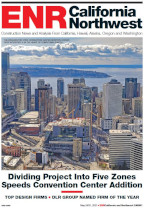 Courtesy of MKA Bridge traveled down city street after traffic lights were cleared out of the way. |
In a single pick, and after removing several traffic lights, crews placed a 150-ft-long prefabricated steel pedestrian bridge at the Phoenix Convention Center on Jan. 22. The bridge connects a new west facility and a north facility being replaced and expanded.
A 440-ton crane performed the 100-ton pick from a 45-ft-deep pit at the level of the lower exhibit hall. The 30-ft-wide bridge was completely prefabricated by Schuff Steel Co., Phoenix, in a staging area six blocks away, says Derek M. Beaman, principal with Magnusson Klemencic Associates, Seattle, the designer for the $600-million expansion of the convention center, now in Phase 2. "They trucked it to the site in the middle of the night and they had to take down the traffic signals in their path" he says. "It was erected in a single pick using a mobile crane that was still in the bottom of the hole." The bridge�s top chord now rises 77 ft above grade.
 Courtesy of MKA Bridge connects two sections of the Phoenix Convention Center. |
James Madden, a project official with Schuff, says it took about a week and a half to pre-build the bridge. The firm has a structural steel contract for the overall stadium job, which includes 17,000 tons. Starting at 2 a.m., the bridge began its slow trip down the main street. "Some steel members protruded within inches of the traffic lights. It was this giant box that went right down the middle of the street," he says.
Corissa Anderson, project manager for the construction manager-at-risk team of Hunt Construction Group. Inc., H.J. Russell & Co. and Alvarado Construction, Inc., says the bridge made it to the site at about 5 a.m. after a 2-hour, 6-block "adventure." It connects the new west building, opened two years ago in Phase 1, and the north building now being expanded. "We had some last-minute adjustments on the west building to make sure there was ample room to get the bridge in the slot," she says. The bridge rests on an expansion joint with bearing pads at the west building, and has a fixed connection at the north building. "It was a perfect fit," says Anderson.
The bridge was positioned north-south, parallel with the street, then turned, raised slightly above its final position, rotated and set into place. The pick took about two hours.


Post a comment to this article
Report Abusive Comment